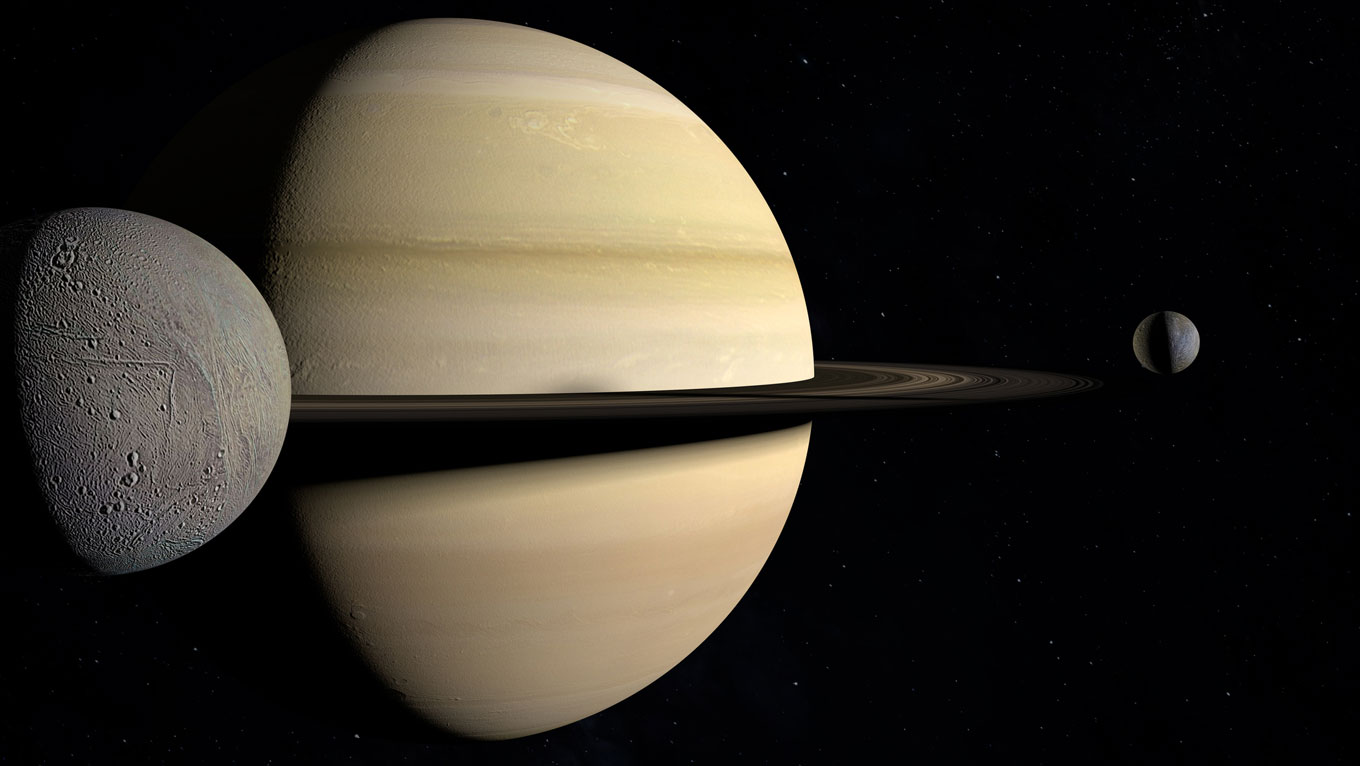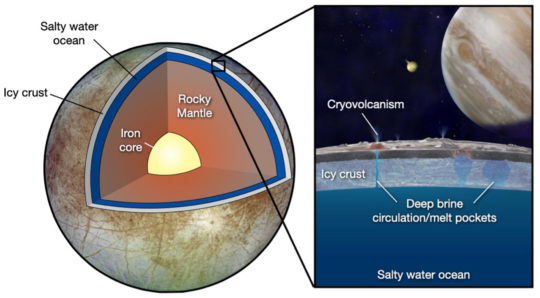 The icy moon Enceladus orbits Saturn. A new way to measure properties of salty water may help us better understand whether these icy ocean worlds can support life. (Photo by iStock)
The icy moon Enceladus orbits Saturn. A new way to measure properties of salty water may help us better understand whether these icy ocean worlds can support life. (Photo by iStock)Study of aqueous salt solutions deepens our understanding of icy planets’ oceans
Researchers at UC Berkeley, in collaboration with the University of Washington, have developed a new way to measure properties of salty water that may help us better understand whether the icy moons in the far reaches of our solar system can support life.
In a study published in Cell Reports Physical Science, a team of researchers led by UC Berkeley postdoctoral scholar Matthew Powell-Palm used an innovative technique to measure for the first time the lowest temperature at which salty water can remain a liquid — the eutectic temperature — at the high pressures present in these icy moon oceans.

Brooke Chang, lead author and materials science and engineering undergraduate student. (Photo by Adam Lau/Berkeley Engineering)
“Knowing the lowest temperature possible for salty water to remain a liquid at high pressures is integral to understanding how extraterrestrial life could exist and thrive in the deep oceans of these icy ocean worlds,” said Powell-Palm, who works in the BioThermal Lab of study author Boris Rubinsky, Professor of the Graduate School at the Department of Mechanical Engineering and professor emeritus of bioengineering. “We can now measure with high accuracy and throughput a fundamental property of aqueous solutions.”
According to the researchers, planetary exploration missions such as NASA’s Galileo and Cassini-Huygens have taught us that icy moons orbiting distant planets like Jupiter and Saturn have deep, salty oceans, with depths exceeding 100 km. But studying these bodies of water from afar has proved challenging because they exist at low temperatures and extremely high pressures, well beyond anything observed in the Earth’s oceans.
Using isochoric — or constant-volume — freezing, an innovative thermodynamic technique pioneered by Berkeley researchers for the cryopreservation of human organs and tissues, the researchers were able to meet this challenge efficiently and with great accuracy. They built an isochoric chamber that supercools the aqueous solutions and self-pressurizes to prevent the growth of ice and salt-rich crystals, keeping the water in a liquid state even at subfreezing temperatures.
The researchers simply set the desired temperature for the solution in the chamber, and due to an often-overlooked nuance of thermodynamics in isochoric systems, the system responds with the corresponding equilibrium pressure. This eliminates the need to perform tedious and time-consuming iterative testing with different temperature and pressure settings.

Example of the deep ocean in the icy moon Europa that may host extraterrestrial life. (Image by NASA/JPL-Caltech, with modifications by Baptiste Journaux)
Among their findings, the researchers identified for the first time that the shift in the eutectic temperature with the application of pressure is very similar across different aqueous salt solutions, despite their varying concentrations and physical properties — a discovery that could impact future studies and approaches to modeling the icy planetary bodies.
“This similarity further revealed that the response to pressure of the minimum temperature for a liquid to exist is mainly controlled by the ice and is relatively insensitive to the behavior of the other solid salt phase,” said Powell-Palm. “This provides an invaluable and fundamental rule-of-thumb for future compositional modeling of different solutes and solutions: The pressure dependence of the eutectic temperature may be roughly approximated by the pressure dependence of the melting point of pure ice.”
These findings also come at a pivotal time in space science research. “Many of the icy moons in our solar system are targets for exploration over the next few decades, with missions planned by NASA’s Europa Clipper, the European Space Agency’s JUICE spacecraft and NASA’s Dragonfly rotorcraft,” said collaborator Baptiste Journaux of the University of Washington. “The new data obtained from this study may help further researchers’ understanding of the complex geological processes observed in these icy ocean worlds.”
In addition to Rubinsky, other study authors from UC Berkeley are Brooke Chang, lead author and materials science and engineering undergraduate student; Anthony Consiglio, co-lead author and Ph.D. student in mechanical engineering; Drew Lilley, Ph.D. student in mechanical engineering; and Ravi Prasher, adjunct professor of mechanical engineering.
